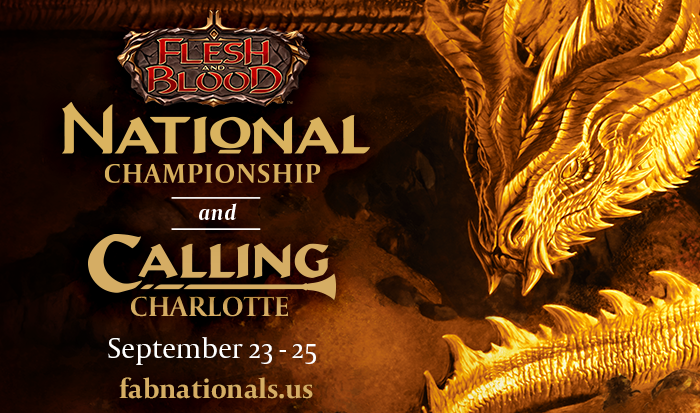Flesh and Blood Nationals season kicks off this weekend following the shakeup of Prism leaving the Classic Constructed format by reaching Living Legend. After just a week of events, including the US Nationals Last Chance Qualifier and Battle Hardened at SCG CON Columbus, players are preparing for a fresh format that will look much different than the CC of the past year where Prism has been a key player.
While US Nationals awaits at the end of the month, Star City Games talked with many of the top players who will be in attendance to get their takes on CC and Uprising Draft. Hear what some of the strongest minds in the game have to say about the two formats that will be on display at Nationals, which will be streamed by SCG on September 23-25 at twitch.tv/starcitygames. Join Bryan Gottlieb, Tannon Grace, Matt Di Marco, and Stephen Cookus for all the action over three days. The broadcast begins at 11:30 AM on Friday, 10:30 AM on Saturday, and 9 AM on Sunday.
Now, let’s meet the players who will be answering our questions.
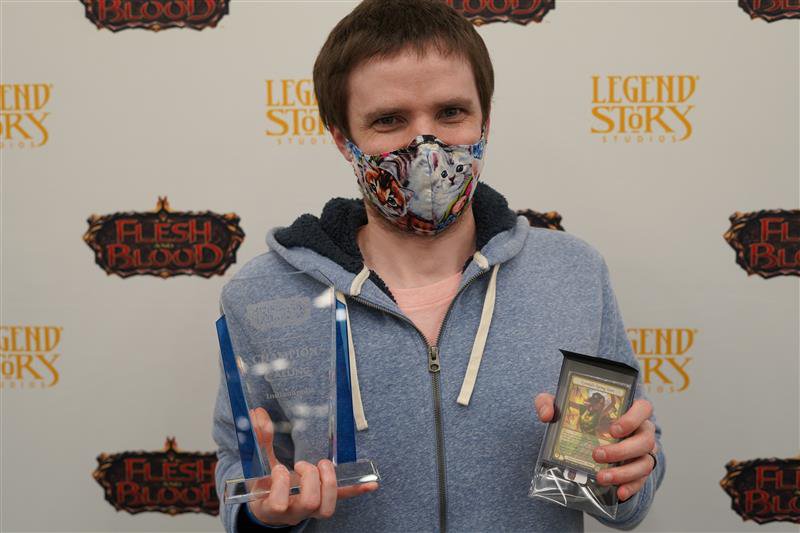
Two-time Calling winner, Michael Hamilton is hot off winning an Uprising Draft Battle Hardened in Lille. Many consider the Guardian specialist the best player in the US.

Brendan Patrick, one of the hosts of the Arsenal Pass podcast, always has his finger on the pulse of Flesh and Blood. With two Calling Top 8s and multiple RNT wins, Patrick is already a storied player in the game.
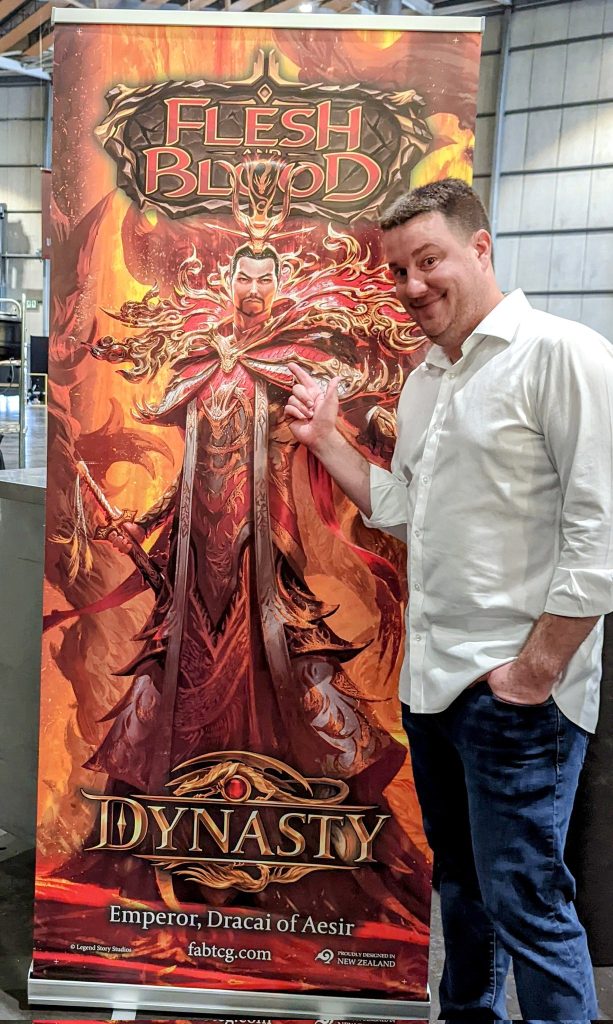
Commentator and competitor, Craig Krempels is experienced at the table and in the booth. A Magic: The Gathering National champion now seeks that title in Flesh and Blood.
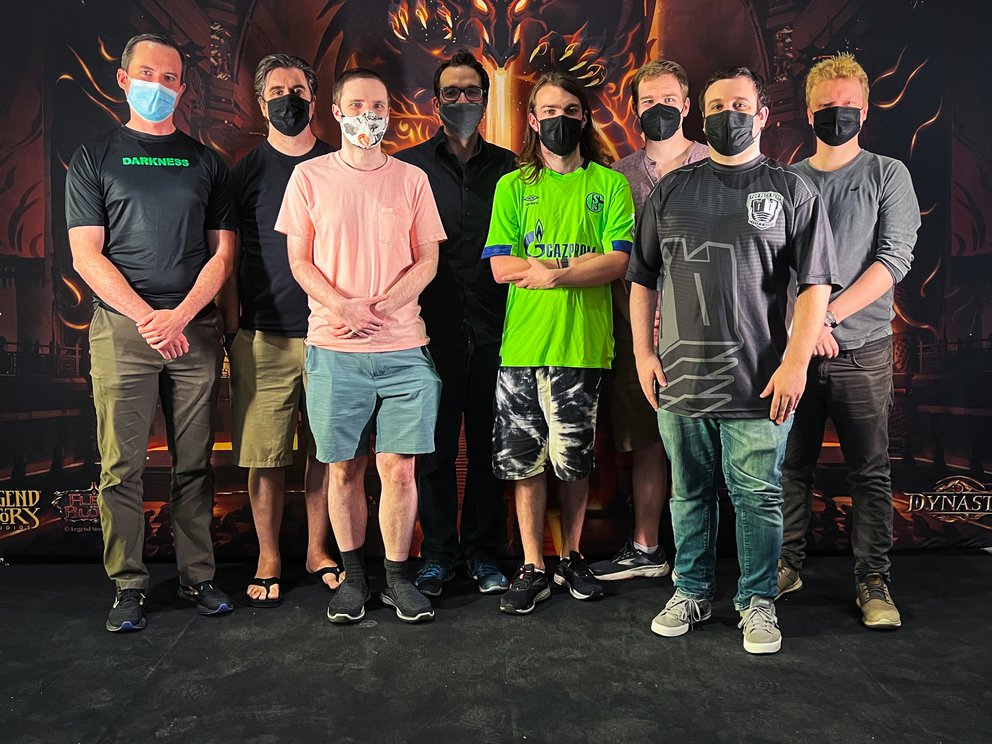
Chris Iaali is coming off a Battle Hardened Top 8 in Lille after finishing in 65th-place at the second Pro Tour. The member of Top Deck Keep is poised for another strong run in Charlotte.
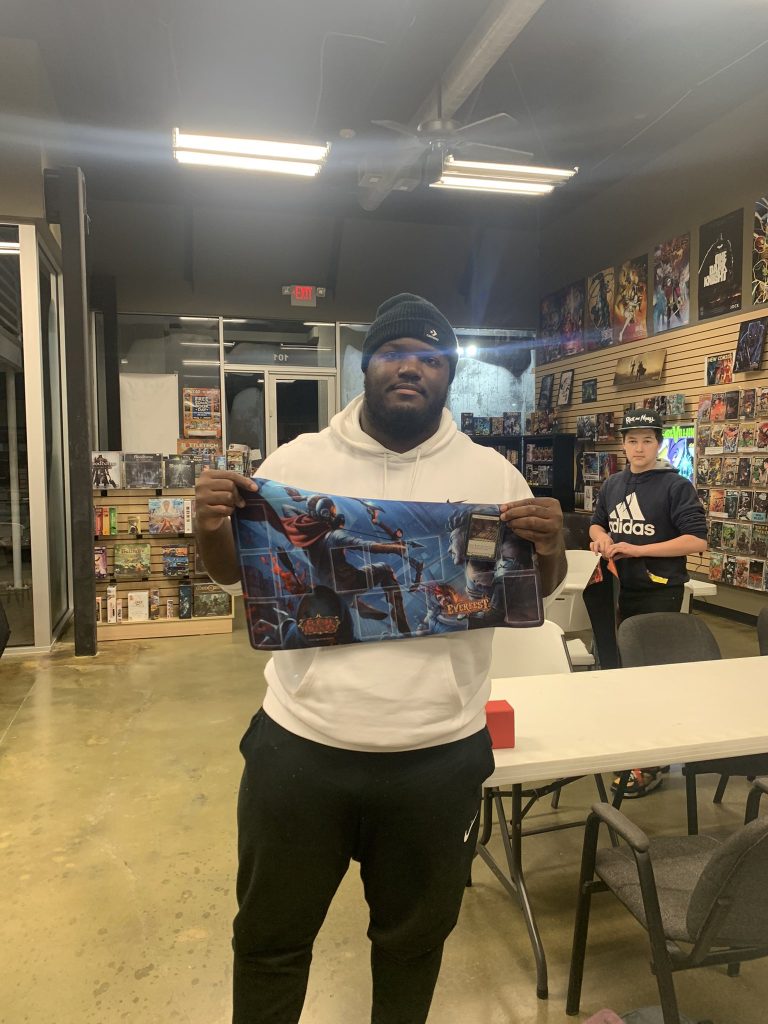
Professional football player for the Tampa Bay Bandits of the USFL and FAB veteran. Mack found time to qualify for both FAB Pro Tours while playing pro ball and is adamant about getting in at least 20 games per day.
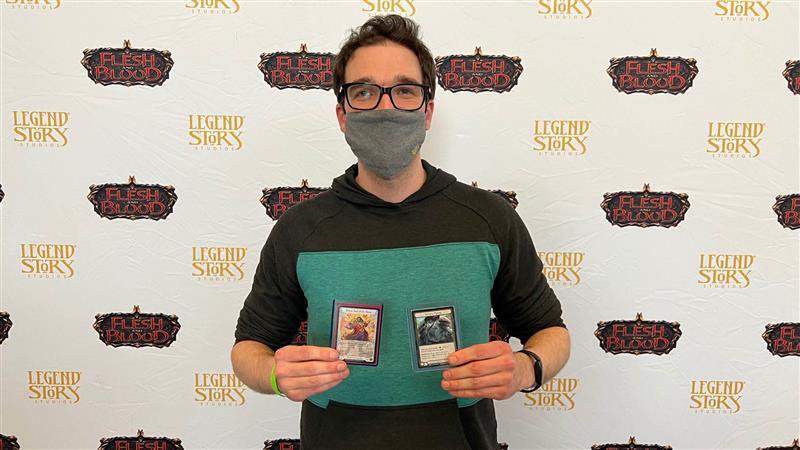
Charles Dunn has four Battle Hardened Top 8s this year, including two wins, and finished in the Top 64 of Pro Tour Lille. Dunn took down a RTN in July, drafting Dromai in all three drafts.
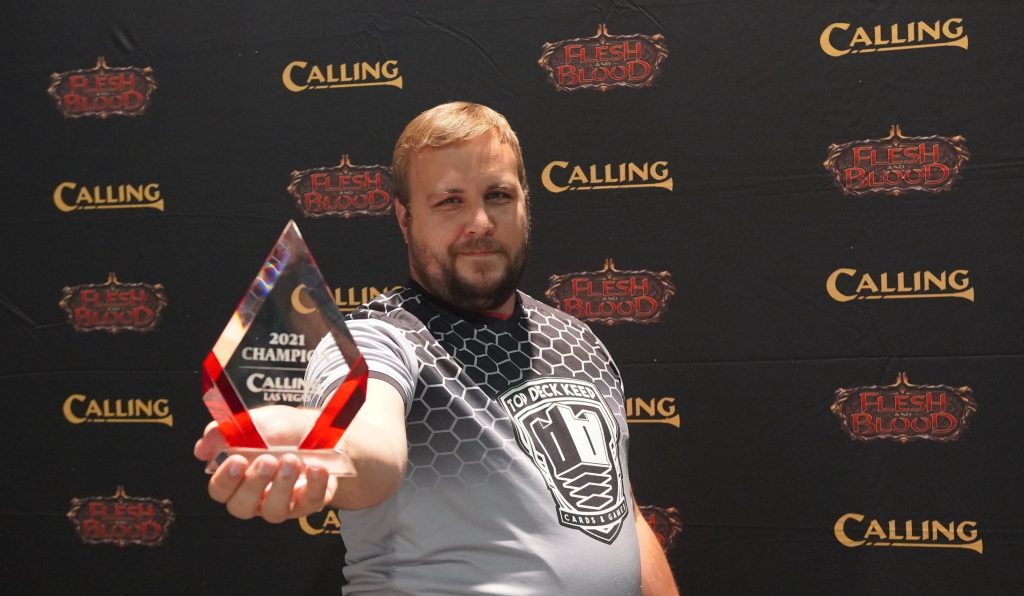
Tyler Horspool, the Calling Las Vegas champion, is coming off a 28th-place finish at Pro Tour Lille. He also finished in the Top 64 at Pro Tour New Jersey and made Top 8 of last year’s US Nationals.
What do you expect the CC metagame to look like for Nationals now that Prism is a Living Legend?
Hamilton: The CC metagame for Nationals will be similar to what it is now, with the notable exception of Prism. After Briar’s recent dominance, I also expect many of the aggro decks to switch from Fai/Viserai to just playing Briar.
Patrick: The recent Prism Living Legend status will likely have a bigger impact on the Flesh and Blood metagame than the entire set of Uprising. Prism is the great equalizer, and while it’s a somewhat non-interactive deck, it was keeping a lot of other degenerate strategies in check… most importantly fatigue.
Krempels: This is the question that is on everyone’s mind. Briar looked to be the biggest winner at the second Pro Tour, but digging a little further into the final standings shows a wide variety of decks having success. Oldhim has traditionally been a great choice if a player was trying to punish very aggressive strategies, but Oldhim had a miserable matchup against the now retired Prism. If Guardians can keep Briar, Viserai, and Fai in check, then maybe the Iyslander players can exploit that situation.
Iaali: I don’t expect much to change at first. The aggressive strategies of the Runeblades, Dash, and Fai will still be popular and the Ice heroes will do their best to control them.
Mack: I expect the CC metagame to actually slow down now that Prism is gone. Prism gate-kept a lot of slower decks and decks that couldn’t generate consistent go again and action points and I expect those decks to be very strong going forward. I think a lot of people should fear Kano right now.
Dunn: The meta is pretty wide open! Prism was a really warping force; many decks did extremely poorly against her, so now that she is gone, a lot of previously under-represented decks will have a chance to shine again. Overall, I expect the meta to slow down quite a bit, since the best way to beat Prism was pure aggression, but since that is no longer necessary, decks will look to optimize more for longer games.
Horspool: We have already seen the initial pushback to Prism being gone at the Battle Hardened. The format is allowed to slowdown considerably with decks like Oldhim and Iyslander being allowed to flourish. Decks that answer those decks like Dash and Dromai will also become more popular. I don’t expect aggro decks to go away entirely but to be a much smaller piece of the pie.
Prism has been around since Monarch, for many players this will be the first time playing without her in the meta. What will be the biggest change? Who are the biggest winners and losers (heroes) now that Prism is gone?
Hamilton: Prism being gone means the field will have many less extremely polarized matchups. Although you could still see success playing Guardians or Wizards in tournaments during Prism’s reign, she had a matchup against those decks that bordered on unlosable for her. Because of that, I expect to see increases in Oldhim, Bravo, Dromai, Kano, Iyslander, Dorinthea, and Lexi.
Patrick: Guardians and Oldhim specifically are the biggest winners, and we should expect them to show up in force during the Nationals season. Other decks like Kano and Iyslander also had very bad matchups into Prism, although I think Kano will still suffer from the recent printing of Oasis Respite.
For anyone thinking about how to prepare for the upcoming meta game, I would recommend they think about how to beat Oldhim and Briar first.
Krempels: Prism was the best control deck in the game but also had the ability to punish poor opposing turns with multiple herald attacks. With heroes no longer being required to put multiple attacks together in order to pressure a life total while also cleaning up auras, it will be interesting to see which previously suppressed strategies can now thrive. Bravo and Oldhim are the most obvious winners, but there is also the possibility of more fringe strategies finding success, such as tall Lexi.
Iaali: With Prism gone, players will be able to register old favorites like Dorinthea and Oldhim without fear. As the meta develops and we get more experience with the new heroes, I expect Iyslander and Dromai to also rise in popularity.
Mack: I think the biggest change of the format will be the pace of play. Games will be far more grindy even for aggro decks. I think the biggest winners are the Guardian and Wizard classes. Prism was very strong into those matchups and were essentially auto losses for those decks.
Dunn: The biggest change will probably be in deck construction, so many decks would have to dedicate at least six sideboard slots to Phantasm popping attacks just because Prism existed. While some of them, like Command and Conquer or Erase Face, are still decent against aggressive decks, they are no longer an auto-include in every sideboard. I expect that most decks will drop these cards in favor of other options.
Biggest winners are obviously Guardians, both Bravo and Oldhim had abysmal matchups against Prism, so they should be the front runners in the new meta. Other less popular decks like Wizards, Dorinthea, and Lexi also stand to gain a lot with Prism gone. Without Prism to worry about, these decks can focus more heavily on countering the remaining decks in the meta.
Biggest losers are probably the pure aggro decks like Fai who preyed on Prism, but had a rough time against Guardians. With Guardians on the rise, I would be nervous about bringing a Ninja to Nationals.
Horspool: Prism being gone is such a huge deal and allows for the metagame to get a lot slower. Oldhim, Wizards, Dromai, Dorinthea and Lexi all stand to benefit from her absence. Briar and Viserai are the biggest losers here as they were the decks that had a good matchup into Prism.
What will the top CC decks be in Charlotte?
Hamilton: If I had to guess the top CC decks in Charlotte, I’d guess: Briar, Oldhim, Viserai, Fai, Dash, and Iyslander. Briar will likely be the most played deck, but there are a lot of decks that can be built to have a solid advantage against her. It’s going to be hard to come up with something completely new in such a short period of time, but any decks that were put down due to Prism’s dominance can definitely be picked back up and tuned for this meta.
Patrick: I believe the top CC decks in Charlotte will be Briar, Oldhim, Bravo, Viserai, and maybe some Fai.
Krempels: Despite the pending shifts due to the retirement of Prism, I expect Briar, Viserai, and Fai to be the most represented heroes. We do have a couple of major events before Nationals that might change my opinion.
Iaali: Briar is still the deck to beat with Prism gone, but I’ll be prepared to face a lot of Oldhim, Viserai, and Dash too.
Mack: Too early to tell right now on which decks will be the top contenders but Dorinthea, Wizard, Guardian and Runeblade all look good.
Dunn: Guardians are the obvious answer for the new top decks, but I wouldn’t entirely discount Runeblades just yet. Historically, Guardians have been strong against Runeblades, but without the threat of Prism in the meta, Briar and Viserai could definitely be built in a way to compete in the long game against Guardians. I also think Iyslander will be a top pick, as she has a strong game against both Guardians and Runeblades.
Horspool: The top CC decks in Charlotte will be Oldhim, Iyslander, Dromai and my dark horse to do very well is Fai. Fai has the tools to thrive in a world where Oldhim and Iyslander are the main decks.
How has the Uprising Draft format changed since its release? What is the best strategy?
Hamilton: The Uprising format has changed significantly since the release of the set. Although forcing Fai is still a playable strategy, most players have realized it isn’t the best way to maximize your chances of winning. He has a difficult Iyslander matchup, and if the hero is over-drafted, it can definitely lose to solid Dromai decks as well. Fai also is the most die-roll-reliant hero in the format, so when drafting Fai, you frequently lose even with the better deck if you don’t get to go second. The matchup triangle in the draft format still exists to an extent, but it isn’t nearly as important as it was thought to be at the start of the format. All three heroes have sideboard cards that can significantly improve any of their matchups.
Patrick: The Uprising Draft format has not changed much since release. The meme of “force Fai” does have credibility and the recent Pro Tour champion, Matthew Foulkes, mentioned that he doesn’t even consider other classes during draft.
I think if players can find a way to consistently draft Isylander and Dromai to success, then they’ll be in a great position. That being said, I do believe Fai has an advantage over both. It’s the easiest deck to draft, play, and can 2-1 most pods with an average pool.
Uprising Draft is also very die-roll dependent, so players should practice that first and foremost in preparation for Nationals.
Krempels: The Uprising limited format is interesting because it requires a slightly different skill set than what was optimal for previous draft formats. Creativity and adaptability are less important than what I would call technical skills. Reading the signals of the person passing to you, sending good signals to the person you are passing to, and having precise pick orders are paramount to success. There is one less card in each Uprising pack which means there often aren’t enough premium cards for anyone to dabble between several heroes and still have a solid deck. Players need to find the open class and then select the right cards for that class.
Iaali: The format has evolved to more than just “force Fai” and players are better at reading signals and pivoting. I prefer to stay open until it’s clear which heroes are being drafted on my right.
Mack: Uprising Draft is more deep than people let on. The best strategy is to force Fai still though.
Dunn: Uprising Draft is remarkably well balanced, I don’t think I could say definitively that there is a best hero. All three heroes are fully capable of winning draft pods. I think Fai has the highest upside, if there are only two Fai drafters at the table, they will probably have really strong decks. But he also really cares about winning the die roll compared to the other two. Overall though, I think the best strategy is to just stay open for the first four to five picks and try to feel out what the drafters to your right are in. If you can identify the open hero early enough, then you will be set up for success.
Horspool: I think it’s obvious that being open to pivoting can be extremely rewarding. Many players become too glued and can’t find the right time to get into another hero when it is obvious yours has too many drafters. The best strategy is to start out in a hero and then continually read whether you need to make one and only one pivot to another.
Do you think there is an underexplored strategy in the Uprising draft format?
Hamilton: At this point in the format, players have drafted Uprising tons of times. It’s hard to say that a strategy is underexplored when all three heroes don’t really have secondary archetypes. Most Fai decks will look similar to each other, barring some power level differences. The same is true for Dromai and Iyslander as well. Although that is the case, I think there are still improvements to be made in terms of individual card evaluations. Over the last weekend in Lille, a lot of my card evaluations shifted slightly, and I expect them to keep doing so as I test for Nationals and Worlds.
Patrick: As for unexplored draft strategies, I believe Team Dragon Shield was aggressively drafting Dromai at the Pro Tour. A great Dromai deck can absolutely 3-0 a pod. The risk is getting three or more Dromai drafters in a single pod, in which case, they likely all lose. Fai doesn’t suffer from the same constraints.
Krempels: I think it would be arrogant to say that with the huge numbers of players and all the talent that has explored Uprising limited, that there would be a successful draft strategy that no one is exploiting.
Iaali: Dromai seems to be the only hero who can support different archetypes, and I’ve been a fan of the more defensive builds featuring less Dragons and more Cenipais.
Mack: It’s hard to have a strategy in draft outside of forcing decks in Flesh and Blood limited. Limited seems to be very restricted in this game compared to others.
Dunn: I am not really sure if there is an underexplored strategy, but the closest thing I can think of is fatigue Dromai. Both Dromai and Iyslander lack a repeatable source of damage from their weapon, so the amount of damage they can do over the course of a game is limited. If you can be defensive enough as a Dromai deck, you can run your opponent out of cards and then win with a single remaining Aether Ashwing. This is how I lost in the Dromai mirror in the Top 4 of Battle Hardened Lille.
Horspool: There isn’t a lot of legroom for unexplored strategies as there are only 14 cards per pack and the heroes are fairly straightforward.
If you had to pick someone other than yourself, who will win US Nationals?
Hamilton: I have to shout out my team, the Wolf Pack! Everyone has been putting in a ton of time getting ready for both the PT and Nationals. I think we have a solid shot at taking it down. Outside of the team though, Michael Feng and Cody Williams both bubbled the Pro Tour Top 8 and crushed Nationals last year. I’d definitely be watching out for the two of them.
Patrick: I would pick Michael Hamilton to win Nationals, and it’s not close. I believe he’s the best player in the world at the moment.
Krempels: Michael Feng has proven to be one of the most elite players in the game. He is my pick because of his previous success, the amount of time that I know he still invests into practice, and because of the talented players he has surrounded himself with.
Iaali: We have so many great players in the US, but my Top 5 to take down Nationals would be Michael Hamilton, Tyler Horspool, Michael Feng, Charles Dunn, and Alexander Vore.
Mack: If I had to pick someone other than myself I’d go with Dagan White.
Dunn: I think my friend Pat Eshghy could win US Nationals. He is a very consistently strong player rated in the Top 25 in both Limited and Constructed. With a long history of high level TCG play in Flesh and Blood and other games, I definitely think he could take it down!
Horspool: The winner of US Nationals would be Michael Hamilton outside of me. The man is a beast at Flesh and Blood and probably the only player outside of Pablo Pintor you could claim is the best player in the world.
Register for US Nationals, the Calling Charlotte, and all other events going on the weekend of September 23-25 here.

